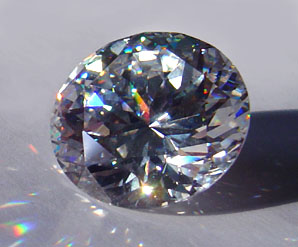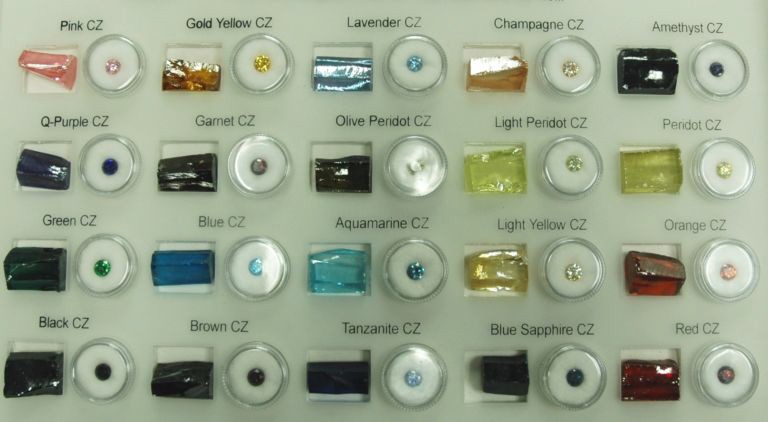|
Cubic Zirconia
Crystals

Little Known Facts
About Cubic Zirconia
Cubic zirconia is a man made gemstone resembling a diamond used in jewelry
settings. German mineralogists discovered cubic zirconia in its natural
setting in the early nineteen hundreds, but has not been found since. It was
originally created to use a refractory material, which is impervious to heat
and chemical damage. Scientists developed cubic zirconia as a new material
to be used in lasers and other optical operations.
The cubic zirconia you see today has been created in a laboratory by
combining the metals of zirconium and oxide through extreme heat and a
monitored cooling process. The temperature required to melt the zirconium is
so extreme platinum containers could not be used in the melting process.
Soviet scientists developed the method still used today to create the carat
stones of cubic zirconia. The process entailed using the zirconium itself to
hold the molten form of zirconium. The extreme temperature used to melt the
zirconium is created by the use of a very large microwave. It allowed the
center zirconium to melt while the outer layer remained cool and solid to
hold the molten form. By 1980 there were 50 million carats of cubic zirconia
created annually by using the method originally developed by the Soviet
scientists.
The production of the cubic zirconia, the melting and cooling of the
zirconium metal combined with the metal oxide, formation of columnar
crystals are produced and then cut into gemstones. Recently manufacturers
have been covering the cubic zirconia with a thin layer of carbon. The
process has resulted in making the material harder. It has also given the
material a more radiant, diamond-like look overall. Covering the stones with
a very thin layer of metal oxide creates the iridescent effect.
Unfortunately the effect is not permanent; a simple scratch can easily
remove the layer of metal oxide.
Because the cubic zirconia so closely resembles a diamond, only a trained
eye can distinguish which stone is the diamond. The differences between the
diamond and the cubic zirconia can only be seen under a microscope. The
notable differences seen under the microscope can be the distribution effect
the cubic zirconia has on light. The cubic zirconia is not as hard as a
diamond. A cubic zirconia will weigh more than a diamond of the same exact
size. The cubic zirconia has in essence no flawless unlike a diamond. Under
a microscope the cuts made in a cubic zirconia have notable differences to
the cuts of a diamond. A diamond is rarely a colorless stone where as the
cubic zirconia can be made with no color at all. Cubic zirconia can be made
in almost any color one could wish for. To produce the color in the cubic
zirconia different metal oxides are used to create certain colors.
Cubic zirconia did not come make its introduction to the market until the
late 1970s and has since had a huge impact on the jewelry industry. Because
the inexpensive cost of the cubic zirconia, its resistance to wear and its
close resemblance to the diamond, the cubic zirconia has become one of the
most used gemstones as diamond replacement since its introduction to the
market in the 1970s. The cubic zirconia's main competition was just recently
created is a synthetic monissanite. However, cubic zirconia has retained its
popularity in the jewelry market. Many people wanting the look of diamond
jewelry without the price tag of diamond jewelry will opt of the cubic
zirconia jewelry instead.
These items can be
used in many ways, your imagination is the limit.
-
By placing crystals
onto a clear piece of glass over a light, the colors will sparkle and light
up any room with a beautiful glow.
-
Placing them into a
crystal or glass vase, in the sunlight or to create a focal point in the
room.
-
Place a candle in the
midst of crystals in a bowl, this will create a bond between the colors and
hopes
-
Place crystals into
water, with a beautiful floating candle
See, use your
imagination, the possibilities are unlimited!
Reds:
protection, courage, energy. Help with
blood, relieve anemia, stop bleeding, heal rashes and wounds.
Pinks: calm, sooth, stop distress, help
with love. They smooth difficulties in relationships, help with self-love
and are good for group rituals.
Oranges: for personal power, self esteem. They
are connected to the Sun, attract luck and success, assists in positive
outcomes.
Yellows: communication, inspiration,
protection, visualization, travel, digestion, nervous system, skin problems,
breathing disorders.
Greens: These are for healing. Eyes,
kidneys, stomach, migraines, esp. Help with money, luck, prosperity,
grounding and balance.
Blues:
calm emotions, sleep, healing, ulcers
and inflammation. Use them in the bath for purification.
Purples: mysticism, purification,
meditation, psychic work, subconscious, health, obedience, headaches, mental
illness, hair problems and sleep.
Whites: These are ruled by the Moon.
Sleep, psychism, promote lactation, protection after dark, gets rid of
headaches
Blacks: self control, grounding,
resilience, quiet power, grounding, invisibility, peace, anxiety.
|








